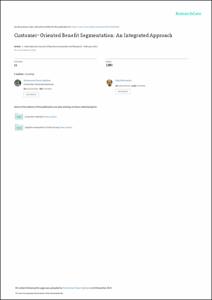Please use this identifier to cite or link to this item:
http://localhost/handle/Hannan/4748
Full metadata record
| DC Field | Value | Language |
|---|---|---|
| dc.contributor | Mohammad Hasan Aghdaie | - |
| dc.contributor | Parham Fami Tafreshi | - |
| dc.contributor | Majid Behzadian | - |
| dc.date.accessioned | 2023-05-05T06:51:35Z | - |
| dc.date.available | 2023-05-05T06:51:35Z | - |
| dc.date.issued | 2014 | en_US |
| dc.identifier.uri | http://localhost/handle/Hannan/4748 | - |
| dc.description.abstract | Segmentation is a common and important task for most marketing departments. Besides, other marketing decisions are influenced by market segmentation results. Benefit segmentation is one of the best approaches for market segmentation among others. In this paper, we proposed a novel hybrid benefit segmentation approach which applied two-stage clustering, conjoint analysis, and Delphi technique to segment customers according to their benefits. More precisely, we used two-stage clustering based on main benefits derived from conjoint analysis to classify customers into different segments. Conjoint analysis was used to assess and balance dissimilar aspects of consumers’ needs. Delphi method was used for the selection of the most important criteria and their levels which conjoint analysis required all of them for evaluation. This approach did not only help managers to segment customers but also to provide a way to analyse consumer behaviour, determine the marking strategy and extract the importance of each attribute in each segment. | en_US |
| dc.language.iso | en_US | en_US |
| dc.subject | market segmentation; benefit segmentation; two-stage clustering; Ward’s method; K-means clustering; conjoint analysis; Delphi method; laptop market; Iran. | en_US |
| dc.title | Customer-oriented benefit segmentation: an integrated approach | - |
| dc.type | Article | en_US |
| Appears in Collections: | تمامی گرایش های مدیریت شامل مدیریت بازرگانی و صنعتی | |
Files in This Item:
| File | Description | Size | Format | |
|---|---|---|---|---|
| 190.pdf | 394.23 kB | Adobe PDF |  Preview File |
Full metadata record
| DC Field | Value | Language |
|---|---|---|
| dc.contributor | Mohammad Hasan Aghdaie | - |
| dc.contributor | Parham Fami Tafreshi | - |
| dc.contributor | Majid Behzadian | - |
| dc.date.accessioned | 2023-05-05T06:51:35Z | - |
| dc.date.available | 2023-05-05T06:51:35Z | - |
| dc.date.issued | 2014 | en_US |
| dc.identifier.uri | http://localhost/handle/Hannan/4748 | - |
| dc.description.abstract | Segmentation is a common and important task for most marketing departments. Besides, other marketing decisions are influenced by market segmentation results. Benefit segmentation is one of the best approaches for market segmentation among others. In this paper, we proposed a novel hybrid benefit segmentation approach which applied two-stage clustering, conjoint analysis, and Delphi technique to segment customers according to their benefits. More precisely, we used two-stage clustering based on main benefits derived from conjoint analysis to classify customers into different segments. Conjoint analysis was used to assess and balance dissimilar aspects of consumers’ needs. Delphi method was used for the selection of the most important criteria and their levels which conjoint analysis required all of them for evaluation. This approach did not only help managers to segment customers but also to provide a way to analyse consumer behaviour, determine the marking strategy and extract the importance of each attribute in each segment. | en_US |
| dc.language.iso | en_US | en_US |
| dc.subject | market segmentation; benefit segmentation; two-stage clustering; Ward’s method; K-means clustering; conjoint analysis; Delphi method; laptop market; Iran. | en_US |
| dc.title | Customer-oriented benefit segmentation: an integrated approach | - |
| dc.type | Article | en_US |
| Appears in Collections: | تمامی گرایش های مدیریت شامل مدیریت بازرگانی و صنعتی | |
Files in This Item:
| File | Description | Size | Format | |
|---|---|---|---|---|
| 190.pdf | 394.23 kB | Adobe PDF |  Preview File |
Full metadata record
| DC Field | Value | Language |
|---|---|---|
| dc.contributor | Mohammad Hasan Aghdaie | - |
| dc.contributor | Parham Fami Tafreshi | - |
| dc.contributor | Majid Behzadian | - |
| dc.date.accessioned | 2023-05-05T06:51:35Z | - |
| dc.date.available | 2023-05-05T06:51:35Z | - |
| dc.date.issued | 2014 | en_US |
| dc.identifier.uri | http://localhost/handle/Hannan/4748 | - |
| dc.description.abstract | Segmentation is a common and important task for most marketing departments. Besides, other marketing decisions are influenced by market segmentation results. Benefit segmentation is one of the best approaches for market segmentation among others. In this paper, we proposed a novel hybrid benefit segmentation approach which applied two-stage clustering, conjoint analysis, and Delphi technique to segment customers according to their benefits. More precisely, we used two-stage clustering based on main benefits derived from conjoint analysis to classify customers into different segments. Conjoint analysis was used to assess and balance dissimilar aspects of consumers’ needs. Delphi method was used for the selection of the most important criteria and their levels which conjoint analysis required all of them for evaluation. This approach did not only help managers to segment customers but also to provide a way to analyse consumer behaviour, determine the marking strategy and extract the importance of each attribute in each segment. | en_US |
| dc.language.iso | en_US | en_US |
| dc.subject | market segmentation; benefit segmentation; two-stage clustering; Ward’s method; K-means clustering; conjoint analysis; Delphi method; laptop market; Iran. | en_US |
| dc.title | Customer-oriented benefit segmentation: an integrated approach | - |
| dc.type | Article | en_US |
| Appears in Collections: | تمامی گرایش های مدیریت شامل مدیریت بازرگانی و صنعتی | |
Files in This Item:
| File | Description | Size | Format | |
|---|---|---|---|---|
| 190.pdf | 394.23 kB | Adobe PDF |  Preview File |
